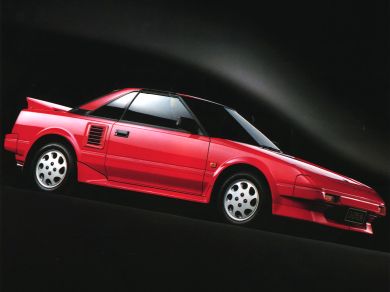
From Wikipedia / Edited for ModernRacer.com
The MR2's life began in 1976 when Toyota launched a design project with the goal of producing a car which would be both enjoyable to drive, yet still provide decent fuel economy. Initially, the purpose of the project was not a sports car. The actual designwork began in 1979 when Akio Yoshida from Toyota's testing department started to evaluate different alternatives for engine placement and drive method. It was finally decided to place the engine transversely in the middle of the car. The result was the first prototype in 1981, dubbed the SA-X. From its base design, the car began evolving into an actual sports car, and further prototypes were tested intensively both in Japan and in California. A significant amount of testing was performed on actual race circuits such as Willow Springs, where former Formula One driver Dan Gurney tested the car.
Toyota made its SV-3 concept car public in the autumn of 1983 at the Tokyo Motor Show, gathering a huge amount of publicity both from the press and the audience. The car, scheduled to be launched in spring 1984 in the Japanese market under the name MR2 (initially standing for "Midship Runabout, 2-seater" but later claimed to be "Mid-engine, Rear-wheel drive, 2-seater") was to become the first mass-produced mid-engined car to come from a Japanese manufacturer.
The small and light first-generation MR2, designated AW11, was perhaps something no one had expected from any of the Japanese car manufacturers, known for their economical and practical cars. The most important features of the AW11 were its light body, superior handling and relatively powerful small-displacement engine. Thanks to these features, the AW11 is considered by many to be very enjoyable to drive. Its behavior mimics that of highly expensive supercars and is easy to control and nimble in its movements. Toyota's cooperation with Lotus during the prototype phase can be seen in the AW11, and it owes much to Lotus's legendary sports cars of the 1960s and 1970s.
As a powerplant, Toyota chose the 4A-GE 1600 cc inline-4 engine with two overhead camshafts and 16 valves. The engine was also equipped with a Bosch L-Jetronic type multi-point fuel injection and a variable intake geometry (T-VIS), giving the engine a maximum power output of 128 hp. US-spec engines were rated at 112 hp, and Euro-spec at 124 hp. This engine had already been introduced earlier in the Toyota AE86 Sprinter Trueno. There was also a Japan-spec model, the AW10, which used the more economical 1500 cc 3A-U engine, but it didn't gain too much popularity.
For the 1986 model year, the AW11 went through several changes which affected both its looks and performance. The most important addition was probably having the option of a removable targa top, which was not available in the US. The exterior was modified by color-coding the bumpers and side stripes, adding small side skirts and a translucent roof spoiler. Other new options included a leather interior and a four-speed automatic transmission. Some further changes were made to the exterior the following year, but more notable were the addition of larger brakes and a heavier C52 transmission which replaced the older C50.
In 1988, Toyota introduced the 4A-GZE motor, equipped with a roots-type supercharger. The engine produced a maximum power of 145 hp and accelerated the small car from zero to 60 mph in 6.7 seconds. In addition to the new engine, the supercharged MR2 was also equipped with stiffer stabilizer bars and reinforcements in the bodyshell to improve rigidity. The press received the AW11 with open arms and praised its innovation, great handling and responsive engine. This model was never sold in European markets, although some cars were privately imported.
The MR2 went through a complete redesign in 1989, when the new Mk II body was introduced. The new MR2, designated SW20 (in USA, the chassis codes were SW20 for the turbocharged model and SW21 for the naturally-aspirated model), was longer, wider and heavier than its predecessor and had smoother bodylines. While the AW11 was a pure sports car, made in the spirit of Lotuses, the SW20, being quite larger, could be classed as a GT-car. The new model was fairly faster than the outgoing one, but the SW20's entry to the market was not quite as smooth as the AW11's. Toyota's goal was to make the car's suspension geometry to work the same way that true supercars do. This made the SW20's cornering abilities quite excellent, but it was much too easy for an inexperienced to make a mistake, leading to sudden oversteer which can result in a spin unless the driver reacts both quickly and correctly. This trait was not considered very desirable among the press, because the MR2 was priced so that even "average people" were able to buy one. Some critics made overstatements where they claimed that the SW20 was downright dangerous to drive. Responding to the negative feedback, Toyota changed the 1993 model to include wider rear tires and changed the rear suspension, while also getting new 15" wheels to fit the larger brakes that were also introduced. Some shifting problems which plagued the first revisions were remedied, but it was still considered a completely different car to the original.
Toyota tried to recapture the spirit of the original MR2 with the third-generation, dubbed the ZZW30. The feedback for the new model was somewhat mixed--others liked its return to the AW11's design concept, while the fans of the SW20 would've liked it to continue along the path of the previous model. All agreed, however, that the ZZW30 had nearly perfect handling, although many complained of its relative lack of power and its oddball styling. It could not match the popularity of the highly-regarded original that wowed the automotive community back in 1984.
© Wikipedia
More Classics...